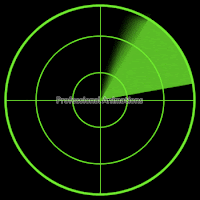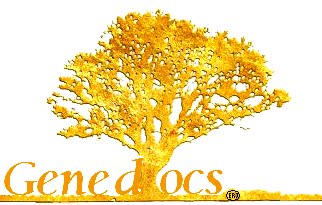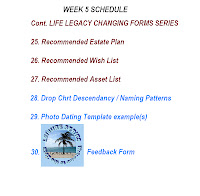.
After some much needed R & R in San Antonio and Galveston Island, I am ready to blog!
.
I notice there is one more blog viewer here and welcome you to my lesser know and not too active writing corner of the web. Most of the activity these days is on Facebook including my posting of exciting examples of Genedocs templates nearly every day.
.
Many of my final course at DeVry were great in that they allowed me to showcase how great Genedocs Charting would be as a business from pre-rootstech until practically graduation day. I have the concept and principles down, but just need to execute a controlled launch with Pay-pal and easy to complete templates that customers would love to e-mail for the transformation into a much better charting option. I will keep after this as more money could keep some bills paid ;-)
.
...anyway on to the blog material. I have many exciting articles to share that merely need to be extracted from the 2009 - 2011 E-Magazines preserved digitally on my computer so let the fun begin!
Here are the first three articles by Eric Jelle in the January 2009 Unveiling Issue:

How to Maximize the Impact Photos Have on Your Family
Tree:
The common
expression “a picture is worth a thousand words” still holds true. Carefully using the family photos you collect
through the years can tell novels about your family without the help of a
single written word. However you’ll
definitely want to elaborate on the details and lives surrounding each of those
precious moments captured in time. For
instance what time frame was the photo taken, who are the people pictured, and
what occasion was important enough to capture on film (or memory card)? Take time to note these and other important
details especially since, with time, everyone’s memory fades. To honor family each of us should spend some
time daily preserving and recording such priceless heirlooms. One day perhaps we’ll thank our descendants
for doing the same for us.
How Siblings can Help You Crash Through Your Brick Walls:
 |
| Most of the Dawes Children of John Thomas Dawes and Johnnie Augusta Gause |


Some
sibling rivalry can result in a tussle and maybe even a few damaged walls if
not controlled, but that is not how brothers and sisters in your family tree
can help you solve the most stubborn family mysteries that researchers commonly
refer to as “brick walls”. A good bit of
research back through generations can be completed by merely searching for the
parents of an individual and, if you’re lucky, one child leads you straight to
their parents’ information. But, in
many cases if that child doesn't have a direct record linking them to their
parents due to a fire, adoption, etc., then your research stalls to a
stop. You might even end up so
frustrated or distracted at that point that you put your research on hold for
precious years. To prevent such a costly
delay one proven technique is to take a step to the side of that child to each
of his or her siblings’ records and more often than not, BAM! You find their parents and are right back on
track. Persistence pays off many times
in genealogy so remember not to give up too easily. Also be creative and who knows – you may be
the next Sherlock Holmes in your family tree.
Researching vs. Preserving Your Family’s Legacy
One of the founding principles of Genedocs is to vicariously overlap family
researchers’ goals with the overall goal of preserving their family’s
legacy. Many genealogists find out very
late on their quest for ancestors that they have a duty to also preserve the
essence of their family history and even more don’t even realize their full
role in maintaining their family’s legacy through protecting their own family
and assets before they themselves depart this world. Only you and you alone can ensure that you
preserve more than monetary assets for generations to come.
is to vicariously overlap family
researchers’ goals with the overall goal of preserving their family’s
legacy. Many genealogists find out very
late on their quest for ancestors that they have a duty to also preserve the
essence of their family history and even more don’t even realize their full
role in maintaining their family’s legacy through protecting their own family
and assets before they themselves depart this world. Only you and you alone can ensure that you
preserve more than monetary assets for generations to come.
VERSUS 
Of course it is highly recommended that you
seek counsel with your most trusted family and professional ad visors
– only
those who have consistently demonstrated the responsibility, maturity, caring,
and respect worthy of contributing to your family’s legacy. Be wary of the black sheep in your family
especially one whose actions have been clearly only self centered, wasteful,
and/or inconsiderate. Trusting a
financially irresponsible family member to honor their word can quickly reveal
a sheep in wolf’s clothing waiting to plunge a knife in your legacy’s back -
solely for their own gain. Just remember
that you can spend decades creating, building, and preserving a priceless legacy
for your loved ones, but all it takes is one foolish moment to have it all
washed away forever. Now that you know
what is at stake let’s get back to research.
Setting and Sticking to Your Research Goals
Before
researching it is best to have an idea of why you’re starting and what you hope
to learn on the journey. Whether you are
a seasoned researcher or just beginning your quest grab a pen and paper (or
open a new document on your computer) and take a few minutes to annotate
exactly what it is that has inspired you to start your family research and some
of the main things you want to try and discover the answers to in your family.
Some of your questions might be...
Are you related to someone famous
or royalty?
Are you conducting medical research
for a genetic family illness?
Do you have a unique last name you
want to find the origins of?
Why are there 5 people named Henry
in the near branches of your tree?
Why did grandpa serve in the
military during a war?
How did my parents or grandparents
meet and fall in love?
Where exactly is that family farm I
hear cousins talking about?
Why is grandma’s grave missing a
headstone?
Believe it
or not many of these same questions were right where some of the best
researchers started their quest to know more about family. These questions and yours help establish the
starting goals of any research into family.
I say starting goals because research is very dynamic and, as you answer
one question/reach one goal, another pops up right in its place or even two or
three. This is part of the reason that
genealogy is considered addictive because it turns you into the family
bloodhound tracking down one mystery after another - perhaps hot on the trail
of a the answer to a brick wall that no one else has been able to topple for
over 200 years. Family research at first
may seem dull, plain, and like someone else or someone older will do it – but
actually it is usually up to people just like you with the energy, excitement,
and inquisitive nature to begin it all. Now
that you have some goals established remember to keep your list handy to remind
you what you are after, what you have achieved, and what is next.



Using Computer Programs to Your Advantage
A benefit
of living now in this new millennium is that nearly everyone has a personal
computer available for use in their home or at least available at the library
or a friend’s home. The majority use
Bill Gate’s Microsoft programs such as Word, Excel, Outlook, Power Point,
Paint, etc. There are free similar
versions at Google.com’s documents section with a simple sign up. I refer to Microsoft programs simply because
they are the tools I used to create many if not all of the forms in the
Genedocs

series.
I highly recommend taking a class or two or just tinkering on your own
with these programs to create some templates, presentations, charts, graphs,
stories or whatever you enjoy. The resulting
benefits are twofold: first you develop
a new skill and second you learn some creativity while working on your hobbies
– hopefully most often genealogy. Strive
to learn more and before you know it you will be an intermediate or master user
of these and other useful programs on a PC or laptop.
Staying Organized and Keeping Creative Flare


One
essential part of research to implement early is organization. You will likely be gathering paperwork,
copies, notes, photos, heirlooms, and anything family tree related so it is
essential that you have a method of organization especially for records, notes,
and irreplaceable photos/heirlooms.
q First
buy a box of file folders just for genealogy – manila with 1/3 cut tabs is fine
to start but as your collection grows you’ll start seeing the advantage of more
pricey expandable folders with several section dividers and two metal prongs
per section to keep everything in place.
q Second
buy at least one records storage box
10” x12” x 16” with side handles and a lid or dedicate a locking
file cabinet (possibly fireproof if you can afford it now) to place files in.
q Buy
lined paper, printer paper, and a box of reliable pens – multicolored if you
are the more creative type. A highlighter
set is a really good idea too for some added color flare.
q Each
file folder is labeled with one ancestor’s name, but starts the first file with
you, before working to your parents, grandparents, etc. To start I recommend 31 files to cover five
generations including you. Every bit of
information you gather on each individual will be placed in their individual
file. Keep the contents organized by
priority: Birth, Death, Marriage info.
first, then follow with education, employment, military service, photos, etc.,
whatever you need.
How you chose to display all of your findings is entirely up
to your own unique creativity so brainstorm whatever you like and write your
ideas down so you can come back to them when you get pulled away. Use colors to distinguish events (green for
birth, red for death, blue for marriage for instance) to keep the visual impact
of your records, files, and creations.
Collect less documented research data - family house blueprints,
recipes, garden arrangements, household inventories are only but a few
examples.
Outlining Your Life Story Made Easy:
Here is a
commonly used content outline for many life stories:
Introduction
Genealogy
Birth
Early
Childhood
School
Years
College (if applicable)
Employment (if applicable)
Military
Service (if applicable)
Marriage (if applicable)
Parenthood (if applicable)
Memorable Vacations
Significant People in My Life
Significant
Personal Events
Significant
Lessons Learned
Thoughts
About Me
My Legacy
My Ancestry (back at least 5
Generations)
Using this format I completed my own Personal History in
under a day – which even surprised me.
I hope you enjoy these. There are a whole bunch more!

































